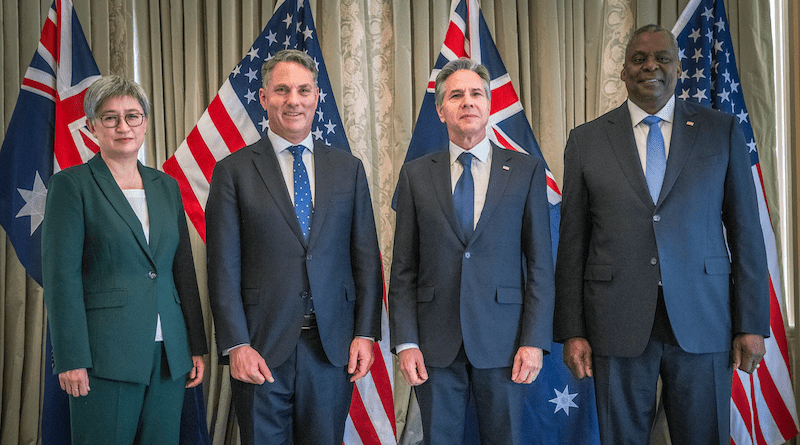Australian, US Leaders Say Alliance Is More Relevant Than Ever
By DoD News
By Jim Garamone
The main message of the annual Australia-United States Ministerial Consultations in Brisbane, Australia, is that the alliance is stronger today than it ever has been.
The consultations – commonly called AUSMIN – featured Australian Defense Minister Richard Marles, who also serves as deputy prime minister; Australian Foreign Affairs Minister Penny Wong; U.S. Secretary of State Antony Blinken; and Secretary of Defense Lloyd J. Austin III.
Those involved commented on the strength of what is commonly called “the unbreakable alliance.”
The meeting follows the AUSMIN held in December in Washington; the defense leaders furthered their work on force posture cooperation, capability development, and effort on outreach to allies and partners in the region. “It all points in the direction of an alliance that’s doing more than ever for peace and stability in the Indo-Pacific,” said a senior DOD official.
“Today, we have had a very fruitful and rich conversation about the state of the alliance — about the state of the world in which we are both operating, its complexity, its volatility, its threat,” Marles said at the conclusion of the meeting. “And as we engage in that world together, all of us have felt that the alliance has never been in better shape than it is right now.”
The meeting was held under the cloud of the crash of an Australian helicopter involved in Exercise Talisman Sabre, a biennial exercise designed to advance a free and open Indo-Pacific. Four Australian service members are missing, and search and rescue efforts continue. Austin told his Australian friends that U.S. forces in the exercise stand ready to help in any way.
Austin said the strategic alignment between the United States and Australia has never been greater. “We share a common vision of a free and open Indo-Pacific, and we’re committed to investing further in our alliance to uphold this vision,” he said.
One concrete example of this cooperation is that the U.S. will “deepen” force posture cooperation with Australia, the secretary said. This also includes upgrading critical air bases in the Northern Territory and pursuing important infrastructure project projects at new locations. “Taken together, these initiatives will strengthen our ability to respond to crisis in the region while enhancing our interoperability,” he said.
The U.S. military will increase the rotational presence of U.S. forces in Australia. This includes Navy maritime patrol and reconnaissance aircraft to enhance maritime domain awareness in the region. “We’re also introducing new rotations of U.S. Army watercraft and expeditionary submarine visits to Australia,” Austin said. “These efforts will bolster deterrence by strengthening our interoperability and enhancing our sustainment and logistics capabilities for critical missions.”
Regular rotations of Army watercraft will enable the United States to determine logistics-related requirements and to facilitate rotations, officials said. “This is fundamentally about building out our combined logistics and lift capability,” the senior defense official said.
The U.S. military will also establish an enduring logistics support area to further expand logistics and sustainment cooperation, Austin said at the AUSMIN press conference.
“We further agreed to expand our cooperation in space, which will improve our ability to coordinate more deeply with Australia in this new and important domain,” the secretary said.
Marles also highlighted efforts in the crucial domain. “In terms of force posture initiatives, we agreed that space cooperation would now form a key part of what we do in our military and defense cooperation, and this is a critical step forward,” he said.
The four leaders called for advancing ties with other regional partners. “We endorsed plans for enhanced, trilateral cooperation with Japan and Australia, which will include F-35 training and cooperation,” the defense secretary said.
The AUSMIN joint statement called enhancing trilateral interoperability “an important investment in credible, effective deterrence.”
The example of the U.S.-Australian ties – and the security benefits realized – is seen throughout the Indo-Pacific, senior defense officials said. Nations of the region see the benefits of a free and open Indo-Pacific where goods, ideas and people can flow freely.
The United States works closely with many nations in the region including India, Indonesia, Malaysia, Singapore, Vietnam and the islands of the Pacific, and those nations see the benefits of working together.
Increasingly, the nations of the region – including U.S. treaty allies like Japan, South Korea, the Philippines and Thailand — are working with other like-minded nations on new ways to support the rules-based international order.
These are initial steps that may – over time – thicken the relationships among the nations of the region. “It’s a really important moment,” the senior defense official said. In 10 years “when the [rules-based] order is strong and has been sustained and maintained and built, I think folks are going to look back on this period and … identify some of these initiatives as the, as really the key building blocks.”

